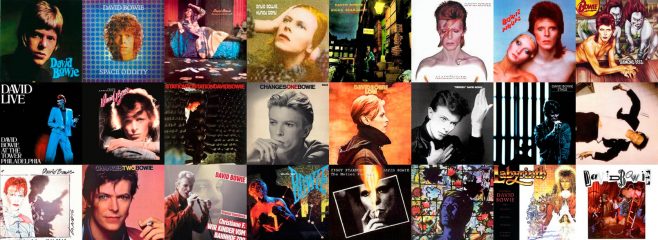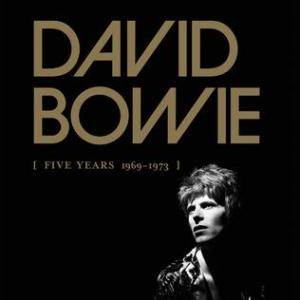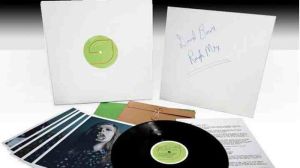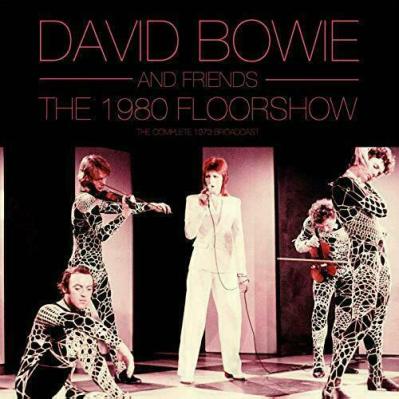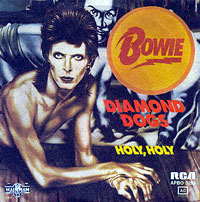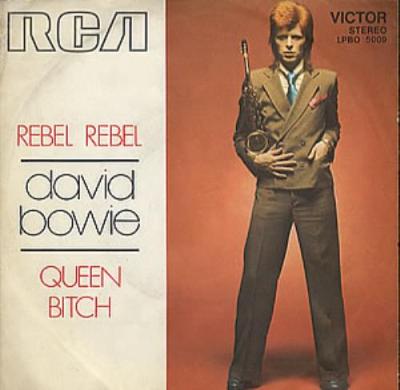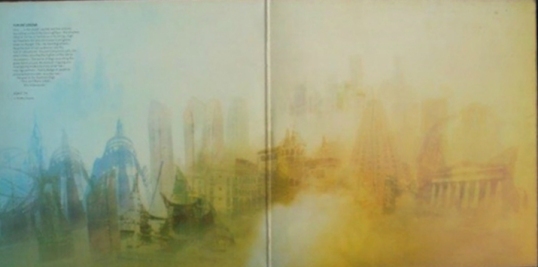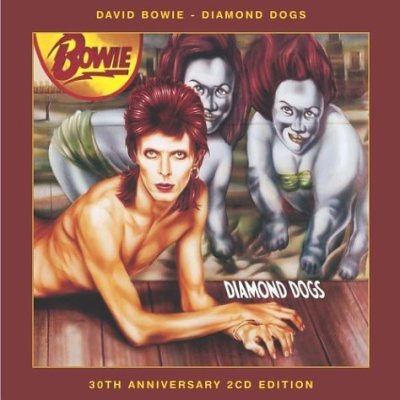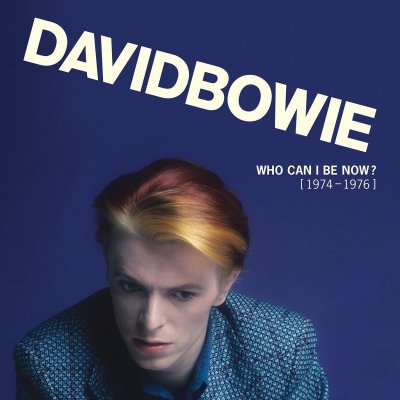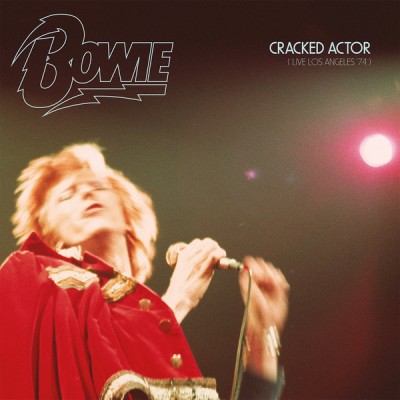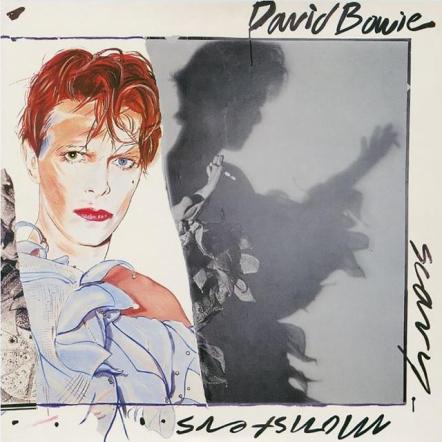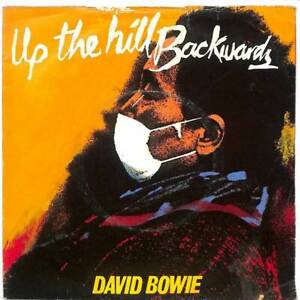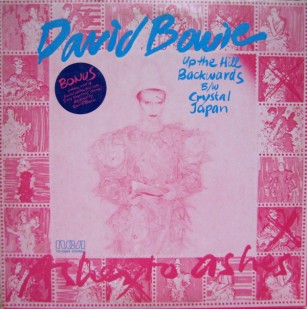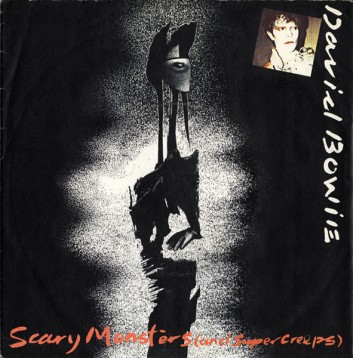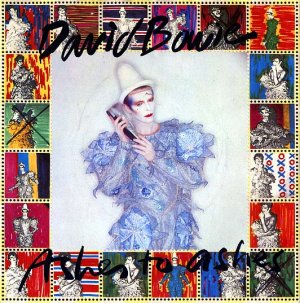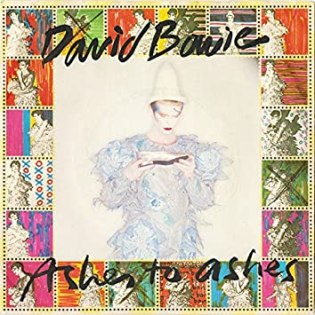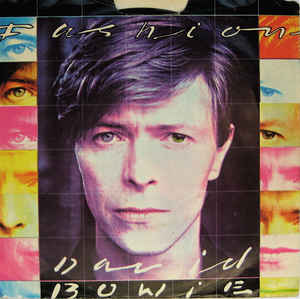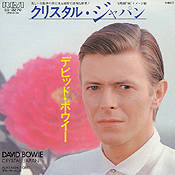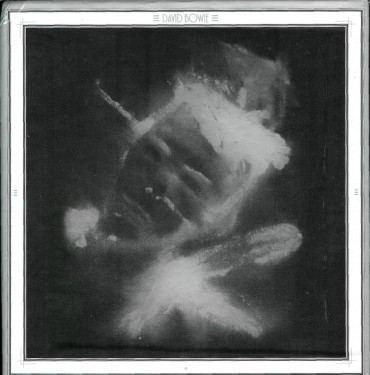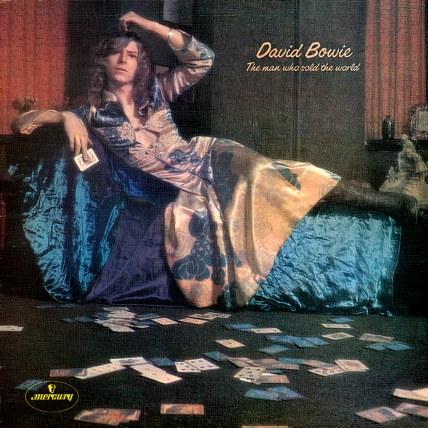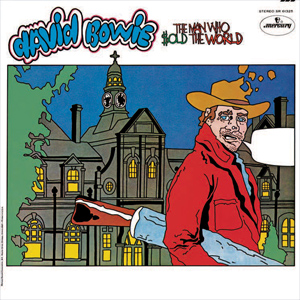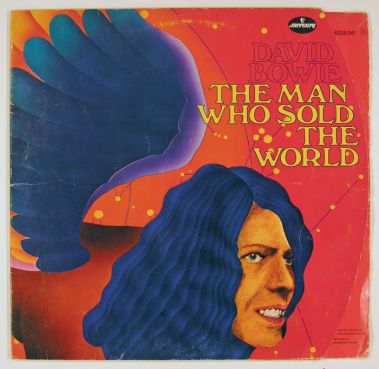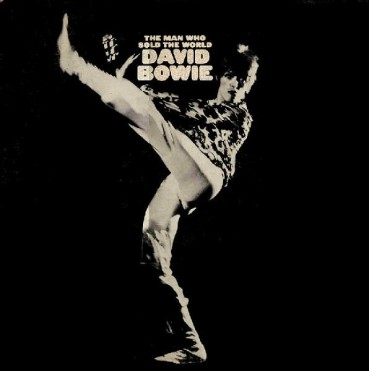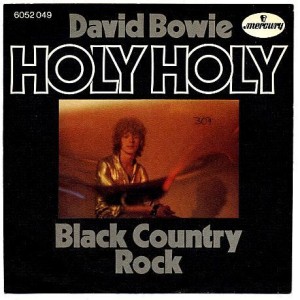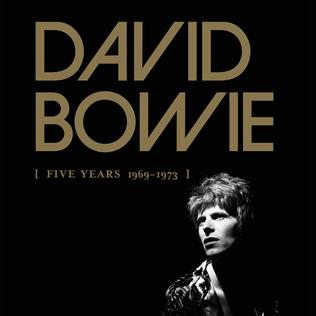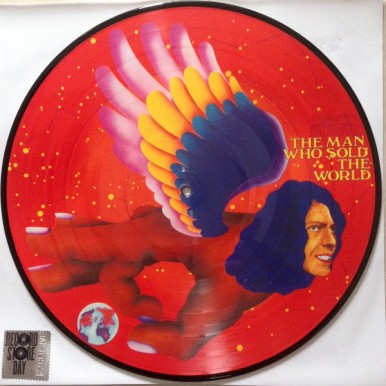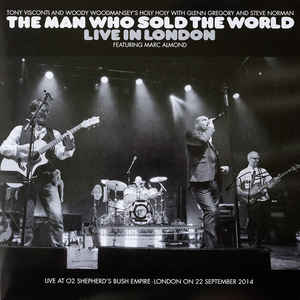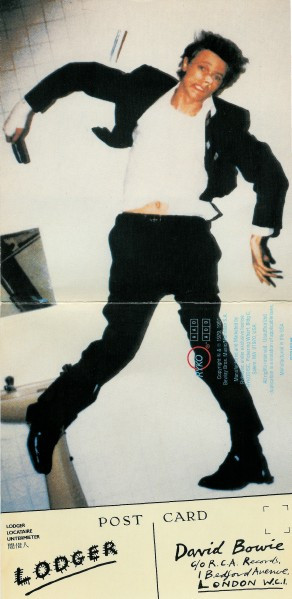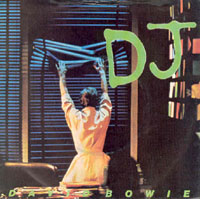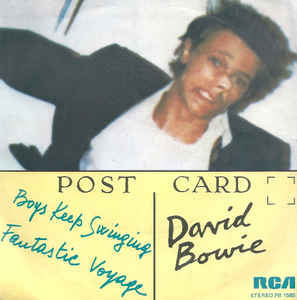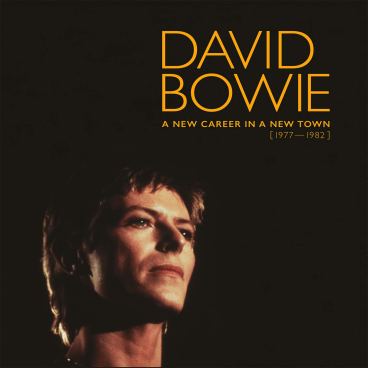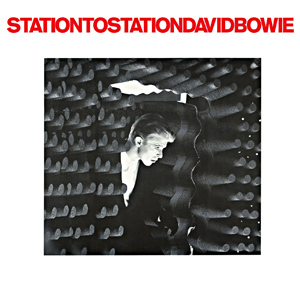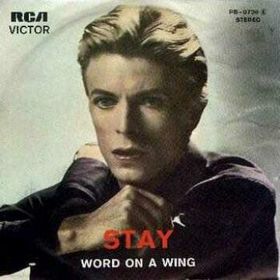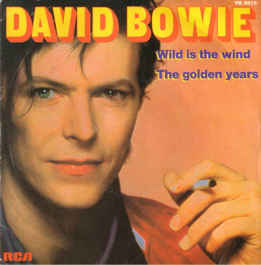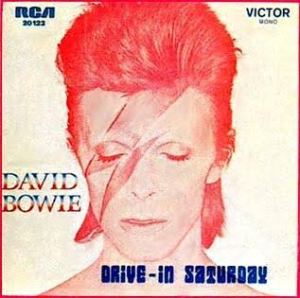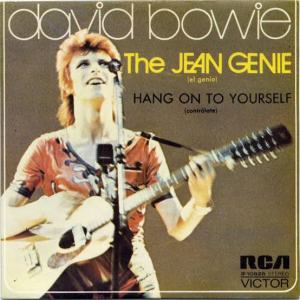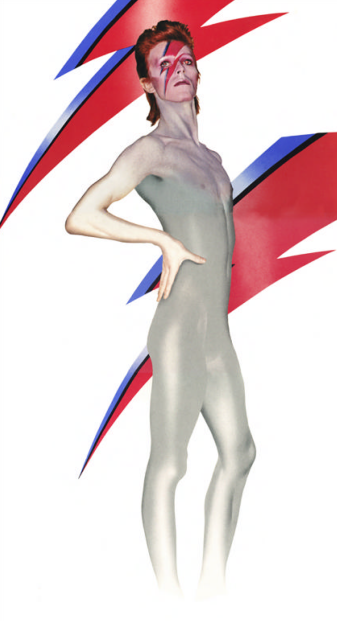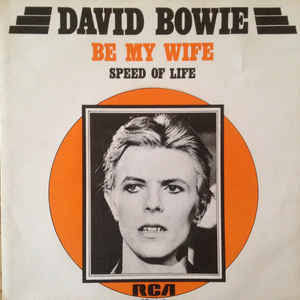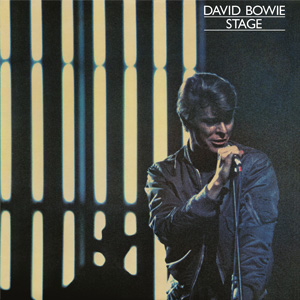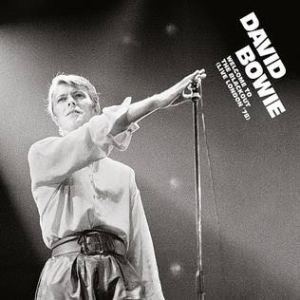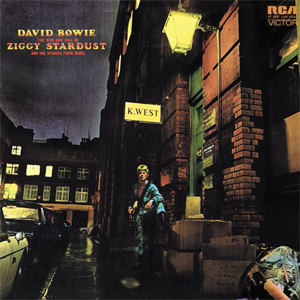
“The Rise And Fall Of Ziggy Stardust And The Spiders From Mars” is David Bowie’s 5th studio album, originally released on 16th June 1972.
In the end, No. 1 had to be Ziggy. It’s not only my favourite David Bowie album, but my favourite album of all time. Which is actually quite remarkable as it was the very first album I ever bought on record (I initially bought all my music on cassette tape as I only had a cheap tape deck in the early days). So when I close my eyes and listen to this remarkable album, I’m instantly transported to my little semi-attached house in Manchester and playing this for the first time on my parents new record player and Castle speakers. It sounded sooooooo good and yes, it’s still sounds so fresh and vibrant and exciting and thrilling and ALIVE today.
But it’s not just that this album has oodles of nostalgia for me. It really is for me musically the perfect album…
Back in late 1971, early 1972, David Bowie was still relatively unknown. Despite being in the music business for an endless 7-8 years with four albums under his belt, Bowie had just the one hit to his name, the “Space Oddity” single back in 1969. But that was all about to change for ever…
All the pieces for his success were now finally in place. In Tony Defries, Bowie had a manager who was now singularly focused on ensuring Bowie got the media attention he needed and cleverly used hype and marketing to give the perception that Bowie was a star whilst still almost penniless. In RCA, he had a record label who were committed to the necessary marketing and promotion needed for success, especially in the US. In Ken Scott, Bowie had a producer who knew how to get the very best out of Bowie and his remarkable songs in the studio. In Mick Ronson, Trevor Bolder and Mick “Woody” Woodmansey, he had the perfect musical foil who could both in the studio and live in concert make Bowie’s music truly shine. But perhaps most importantly, Bowie’s song writing had reached a golden period, where he had really clicked and was writing song after song of an incredibly high calibre. His previous album “Hunky Dory” was a tour de force of amazing song craftsmanship. Unbelievably, even before his previous masterpiece had even been officially released, Bowie was already in the studio excitedly recording his next album with another set of brilliant new songs.
However, rather than just a collection of great songs, Bowie had a half formalised idea for a concept album, one which told the story of Ziggy Stardust, an alien who would arrive on earth as a cosmic savior as the world was nearing a nightmarish end due to some unspecified apocalypse and through music would bring hope to a desperate population. However success and the inevitable, unavoidable end would all be too much for Ziggy, who ultimately perish at the hands of his devoted fans.
The Ziggy Stardust character would be based on various influences, including Iggy Pop, Marc Bolan, Jimi Hendrix, The Stardust Cowboy, Syd Barrett and perhaps most pivotal of all, Vince Taylor, a 1960’s rocker who would suffer from a mental breakdown at the height of his (mainly European-based) success. Although Bowie had developed quite a detailed story-line, at least in his head, the final album had a very loose concept with Ziggy no more than a vague thread than runs through the album, rather than any real coherent narrative. Side One of the album can be seen as setting the scene and describing somewhat Ziggy’s environment and arrival, where Side Two more specifically tells Ziggy’s tragic tale, although most of the narrative is actually condensed within the title track itself.
The album opens with Woody’s iconic slowly fading-in drum beat that is the introduction to “Five Years“. The band joins in with a mainly piano and guitar based riff as Bowie opens with the unsettling “Pushing through the market square, So many mothers sighing, News had just come over, We had five years left to cry in“. Bowie then details the reaction of various people at the awful, apocalyptic news that mankind only has 5 short years remaining. The music slowly builds as Bowie observes events around him such as “A girl my age went off her head, Hit some tiny children” and later “A cop knelt and kissed the feet of a priest, And a queer threw up at the sight of that“. Ronson’s lovely string arrangements are then introduced as Bowie sees his girlfriend, oblivious to their doomed future and has the heartbreaking task of telling her the nightmarish news “Smiling and waving and looking so fine, Don’t think you knew you were in this song“. It’s just all too much and as the music reaches it glorious crescendo and the strings explode out, Bowie sadly recants “We’ve got five years, my brain hurts a lot, Five years, that’s all we’ve got” before finally literally screaming “FIVE YEARS !!!” in sheer terror and anguish. Woody’s awesome drum performance then ends as it began, as it slowly fades away. It’s an extraordinary vocal performance, one Bowie could never quite replicate live as it would quickly destroy his voice and shred his vocal cords.
If this isn’t the best opening to any album, then I haven’t heard it. It’s one of Bowie’s very finest moments on record and we’re only up to the first track. Bowie would perform the song on and off throughout his career, in some of the early Ziggy Stardust shows, during the “Station To Station Isolar I” tour and “Stage Isolar II” tours and then finally on his last “Reality” outings.
Bowie introduced Ziggy Stardust to the world way back in February 1972 a few months before the album’s release when he performed “Five Years” on the “Old Grey Whistle Test”. Watch this iconic performance here.
The “Five Years” outro drum beat merges seamlessly to the intro drum beat to “Soul Love“, a song that describes the contradictions and failings of love within the Ziggy universe, from the perspectives of a grieving mother, young lovers and a lonely priest. It has a rather lovely, catchy melody played predominantly on Bowie’s acoustic guitar, with Ronson’s guitar at perhaps its most restrained on the album. Although the music has an uplifting feel, especially when Bowie plays his rather cute saxophone solo, there’s a sadness in each of the three vignettes; the grieving mother “Stone love, she kneels before the grave, A brave son, who gave his life“, the two young lovers “New words, a love so strong it tears their hearts” and the priest “All love, though reaching up my loneliness evolves, By the blindness that surrounds him“. In the chorus, Bowie reminds us how love encompasses all “Love is careless in its choosing, Sweeping over cross and baby” but in a doomed world, love might not be enough “All I have is my love of love, And love is not loving“. These are all people in desperate need of a saviour…
Other than the 1978 Isolar II tour where is was a fixture of the Ziggy Stardust resurrection within the setlist, it’s a track that Bowie very rarely performed live.
The saviour arrives in the next track, the cosmic experience that is “Moonage Daydream” and perhaps the centrepiece of the album. Following Ronson’s power chords, Bowie introduces us to Ziggy with the immortal lines “I’m an alligator, I’m a mama-papa coming for you, I’m the space invader, I’ll be a rock ‘n’ rollin’ bitch for you“. Things only take off from here on in, with The Spiders at their absolute best studio form, creating hard rock stereophonics that truly takes you to another place. The first verse though is relatively subtle, with mainly Bowie’s acoustic guitar and Bolder on bass covering most of the melody lines. Things expand out in the chorus, with the piano joining in the fun and the “dooooo” backing vocals as Ziggy pleads “Keep your ‘lectric eye on me babe, Put your ray gun to my head“. Ronson’s superb guitar is more prominent in the second verse, as Ziggy ties things back to love themes from the previous “Soul Love“, “Don’t fake it baby, lay the real thing on me, The church of man, love, is such a holy place to be” before diving into the chorus again “Press your space face close to mine, love, Freak out in a moonage daydream oh yeah“. We then arrive at the first musical break, where Bowie’s baritone saxophone and what sounds like a tin whistle dominate before literally soaring into the choruses again, the music building and building in intensity with Ronson’s amazing string arrangements kicking in. Ziggy’s voice expands out as he cries out the lyrics, echoing now as if resounding out into the cosmos. Ronson’s epic guitar solo bellows out as Ziggy commands us all to “Freak out, far out, in out“. The final minute plus of this track is undoubtedly Ronson’s finest moment on record, a soaring masterpiece of distorted guitar heroics that combined with his swirling strings creates a space-opera soundscape that always takes me to a special place. It’s a truly amazing song and when played at maximum volume (as suggested on the back of the record sleeve), it just sounds superb. Ziggy has most definitely arrived !!
An early version of Moonage Daydream was recorded for Bowie’s aborted Arnold Corns project (more on this later).
During the subsequent Ziggy Stardust tours, this track would be one of the highlights, with Ronson’s guitar solo expanded out to give time for Bowie to nick out for a quick costume change. It would also feature on a number of other tours, including the “Diamond Dogs” and “Outside” tours.
“Starman” comes next, a hugely important track in the Bowie cannon as it was the introduction to Bowie for a generation when performed on Top Of The Pops on 5 July 1972. It’s Ziggy preaching via radiowaves to the doomed youth that there is still some hope of salvation. Starting with Bowie’s acoustic guitar, a young person is amazed at the starman’s message suddenly coming across on his radio “Came back like a slow voice on a wave of phase haze, That weren’t no D.J. that was hazy cosmic jive“. The Morse Code like bridge takes up into the soaring chorus, inspired (copied) from “Somewhere Over The Rainbow“, with a warning about our Ziggy “There’s a starman waiting in the sky, He’d like to come and meet us, But he thinks he’d blow our minds” as Ronson’s string arrangements adds to the overall atmosphere. Ronson is again wonderful on guitar here with the solos after the chorus combining beautifully with the strings. In the second verse, the story teller shares his story with a friend and is delighted to hear he too heard the starman “I had to phone someone so I picked on you, Hey, that’s far out so you heard him too” with his arrival strictly for the youth (with a throwback to “Oh You Pretty Things“), “Don’t tell your poppa or he’ll get us locked up in fright“. The final “la la la la” coda is very reminiscent of Marc Bolan’s sound with T. Rex who was at the time indeed dominating the airwaves. Overall, it’s the perfect single. Which kinda makes it remarkable that the track only just made it onto the album after RCA wanted something that was more “single-worthy” to be included to promote the album. It was written and recorded at the last moment and replaced the Chuck Berry cover “Round And Round” on the album and thank goodness because the album is most definitely the better for the replacement (more on “Round and Round” later).
Starman was released as the lead-off single on 28 April 1972 and reached No. 10 in the UK charts, making it Bowie’s second hit single, a long 3 years after the “Space Oddity” success in 1969. In fact, many considered it as being Bowie’s only single since his previous likewise outer-space themed track. Bowie first performed Starman on TV on “Lift-Off With Ayshea” but it’s Bowie’s iconic performance on Top Of The Pops that’s most fondly remembered. This rest as they say is history. Watch Bowie perform Starman on Top of The Pops here.
Starman would feature on many of the earlier Ziggy Stardust dates before being dropped, with it only returning to the live sets during Bowie’s “Sound and Vision” greatest hits tour in 1990. The fact it didn’t even make it on Bowie’s first greatest hits package “ChangesOneBowie” suggests that Bowie was not overly fussed with the song. For me, it will forever remain a true Bowie classic.
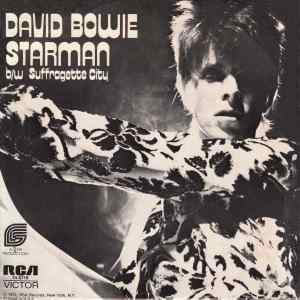
The first side ends with the oddity of the album, “It Ain’t Easy“. The only cover on the album, it’s an otherwise virtually unknown song by American songwriter Ron Davies. It’s a nice enough track, with a catchy sing-along chorus and nice guitar licks by Ronson, but it just doesn’t feel quite right on the album and lacks relevancy within the album’s overall concept (except that obviously life indeed ain’t easy when you know the world will soon end). I view it as Ziggy simply taking a break on the top of a mountain, taking in the views of Earth before the rush that is side two of the album. However, “Sweet Head” or even “Velvet Goldmine” (both discussed later) would have made a much more fitting end to side one.
It’s clearly the weakest track on the album and as far as I’m aware, has only been performed live once by Bowie, during a BBC John Peel radio show where the song ended the session with a different Bowie guest singing a verse (as can be found on the excellent “Bowie At The Beeb” album).
Side Two kicks off sedately enough with the lovely “Lady Stardust“. Sung from the perspective of an adoring Ziggy fan, frustrated and angered at the naive reactions of others at a concert, the mainly piano based arrangement throws us back to the vibe of the previous “Hunky Dory” album. The opening lines “People stared at the makeup on his face, Laughed at his long black hair, his animal grace” are clearly references to Bowie’s friend and contemporary inspiration Marc Bolan. Mick Ronson’s piano part is perfect melancholy as the fan watches his idol in action “And he was alright, the band was altogether, Yes he was alright, the song went on forever” and shows his love despite the sadness of the situation “I smiled sadly for a love, I could not obey, Lady stardust sang his songs, Of darkness and dismay“. He finally can’t hide his disdain for those ignorant around who don’t share his love for Ziggy “Oh how I sighed when they asked if I knew his name“. It’s really is a beautiful song.
That said, it’s a song that Bowie rarely performed live, except at some of the early Ziggy Stardust shows. At a concert at the Rainbow Theatre in August 1972, Bowie projected Marc Bolan’s image on a screen to make perfectly clear his inspiration for the song. It also features on the “Bowie At The Beeb” album.
Things really begin to rock out on “Star“, as Ziggy details his plans for rock ‘n’ roll stardom, while those around him falter and fail “Tony went to fight in Belfast, Rudi stayed at home to starve, I could make it all worthwhile as a rock & roll star“. The Spiders really rock it here, with a frantic bar-room type piano and the band unit thumping out a driving rhythm. Bowie sounds at his most fake american here, while the backing vocals are simultaneously delightful and hilarious. Ziggy doesn’t hide his true motivations; “I could do with the money, I’m so wiped out with things as they are” but is convinced he has what it takes to make it “I could make a transformation as a rock & roll star” and “I could play the wild mutation as a rock & roll star“. As the music calms down at the end, Ziggy makes his final proclamation “Just watch me now“. It’s a wonderful modernised example of an old-fashioned rock ‘n’ roll song about the virtues of rock ‘n’ roll.
For some unknown reason, “Star” didn’t feature in the Ziggy era live shows, only making it’s live appearances during the 1978 Isolar II and the 1983 “Serious Moonlight” tours.
The same can’t be said for the wonderful “Hang On To Yourself“, which generally opened the Ziggy Stardust era live shows. Starting life as a slower paced piece with decidedly different lyrics as one of the songs recorded as “Arnold Corns” (more on this later), this version is infinitely superior, with lots more frantic energy and saucier lyrics. Ostensibly about the perils and temptations of groupies, it opens with the killer lines “Well, she’s a tongue twisting storm, She’ll come to the show tonight” while later “She’s a funky-thigh collector, Laying on electric dreams“. Again, the Spiders are all in fine form here with a driving, punchy riff that takes one on a joyous trip. Other than the title track, it’s the only other time when they get a mention in the lyrics “Well, the bitter comes out better on a stolen guitar, You’re the Blessed, we’re The Spiders From Mars“. Ronson’s guitar riff after the chorus and in the outro is just infectious as is Ziggy’s “Come on ha, Come on, ha“. It’s yet another example of Bowie at his best when he hits the groove.
“Ziggy Stardust” comes next, where the entire Ziggy plot is essentially condensed down to this wonderful song. Starting with Ronson’s iconic guitar riff, it’s one of the most identifiable moments in rock history. Bowie as the narrator (who I have always thought to be one of The Spiders) introduces us to Ziggy “Ziggy played guitar, jamming good with Weird and Gilly, And the Spiders from Mars“. Ziggy is an amalgamation of various persons, including part Iggy Pop, part Jimi Hendrix “He played it left hand“, part The Legendary Stardust Cowboy, part Marc Bolan and in large part Vince Taylor. Our Ziggy is your archetypal rock star “He could leave ’em to hang, ‘Came on so loaded man, well hung and snow white tan” but the usual jealousies are coming into play at the end of each verse “Became the special man, then we were Ziggy’s band” and “So we bitched about his fans and should we crush his sweet hands?“. Musically, it’s not just Ronson who shines here, although his guitar flourishes throughout are just divine, but both Bolder and Woody also make a tight unit that drives the whole piece along, especially during the refrains. At the end, Bowie depicts Ziggy’s downward spiral “He took it all too far but boy could he play guitar” although it’s typically ambiguous exactly how it all ends “Making love with his ego Ziggy sucked up into his mind, Like a leper messiah, When the kids had killed the man I had to break up the band“. The track ends with Bowie’s final cry, stated in the past tense of how “Ziggy played guitar“. This track is the very definition of classic rock ‘n’ roll.
Bowie would of course perform the song live during his Ziggy period and on/off throughout his career, perhaps most notably on 1978 Isolar II tour where much of the album was given a resurrection. Watch Bowie’s 1978 performance here.
The super-charged energy that is “Suffragette City” comes next. Bowie’s acoustic guitar is buried by the banging piano that is undoubtedly a nod to Little Richard, while Ronson’s power chords and the Spiders driving rhythm is pure Velvet Underground x 10. This is Glam Rock at its very best, with Bowie’s vocals nominally detailing Ziggy’s decline to the abyss, while being constantly hounded by “Henry” who could symbolise the press/groupies/his own insanity, with lines such as “Hey man, oh leave me alone you know“, “Hey man, my work’s down the drain“, “Hey man, oh Henry, don’t be unkind, go away“. The chorus builds up the musical intensity even further where an ARP synthesizer kicks in with a sax-like drone as Bowie cries out “Oh don’t lean on me man, ’cause you can’t afford the ticket, I’m back on Suffragette City“. The highlight of course is the false ending, with Bowie’s sexually charged “wham bam thank you ma’am” bringing things back to life. The back of the album cover had the classic instructions “To be played at maximum volume”. I suspect it applies most specifically to this amazing track.
The song entered the bedrooms of many a teenager prior to the album’s released via being the B-side to the “Starman” single. It’s one of Bowie most played live tracks, making the set-list of many a concert. I’ve used this word a number of time I know, but this really is yet another Bowie classic.
The final cry of “SUFFRAGETTE!!” leads us directly to the quiet slowly strummed acoustic guitar introduction of the album’s finale “Rock ‘n’ Roll Suicide“. With “Five Years” as one of the best ever openings to an album, this is undoubtedly one of the greatest songs ever to close an album. The song starts slowly as it details Ziggy’s sad demise, the tragic washed-up figure for whom “Time takes a cigarette, puts it in your mouth” and slowly builds and builds. The second verse introduces Ronson’s initially subdued electric guitar before the band kicks in as the song’s narrator describes the dis-shrivelled Ziggy “Chev brakes are snarling as you stumble across the road, But the day breaks instead, so you hurry home“. The narrator loves Ziggy (the same fan perhaps from “Lady Stardust”, now his last fan) and is desperate to save him, but it’s all too late. The music continues to build as he cries in desperation “Oh no, love, you’re not alone“. Ronson’s wonderful strings arrangements now break in, creating a wall of sound as it all becomes more desperate “You got your head all tangled up, but if I could only make you care” before Bowie literally screams “You’re not alone” in a manner similar to how it all started in “Five Years”. The final section is just a crescendo of sound and emotion as Bowie pleads for Ziggy to “Gimme your hands, ’cause you’re wonderful, Oh, gimme your hands” before Ziggy ends it all and jumps into oblivion…
Wow. I mean seriously wow, what a way to end the show.
It’s important to note that many of the vocal performances on the album were basically first takes, with future takes often regarded as inferior to the original. Recordings were done at a super fast pace, this track basically recorded near the end of the sessions in just one day (4 February 1972)…
Bowie would of course indeed end all the Ziggy shows with this amazing track, most notably on 3 July 1973 when Bowie indeed killed Ziggy on stage as he announced he would never tour again to screams of utter disbelief (not least from Bolder and Woodmansey who were both clueless it was all about to end). Watch this icon final performance here.
On 11 July 1974 during a (very) brief lull in new material, RCA decided somewhat oddly to release “Rock ‘n’ Roll Suicide” as a single. Considering it had been over 2 years since the album’s release and most fans already had the album (and “Quicksand” on the B-Side), it’s a sign of Bowie’s popularity that it reached as high as No. 22 on the UK charts.
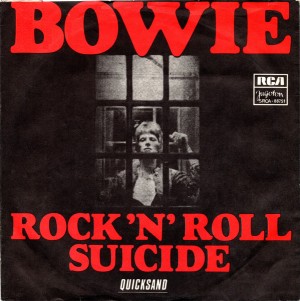
Of course, as remarkable an album “The Rise And Fall Of Ziggy Stardust And The Spiders From Mars” is, there was a lot more to the Ziggy Stardust phenomenon than just a record. Bowie literally BECAME Ziggy, first with the image that initially started with his short cropped spiky hair, dyed a bright “martian” orange before transforming into a bright luminous red and the famous mullet that became the iconic hairdo of the Glam period. Then came all the costumes that became more and more outrageous as things progressed, many inspired by Japanese kabuki theatre. Bowie wore the outlandish clothing both on and off the stage, with Bowie staying in the Ziggy character during interviews and blurring the lines between fantasy and reality. Bowie’s famous “I’m gay and always have been” interview with Melody Maker and his androgynous alien looks just added more fuel to the fire of a more “colourful” existence, than the boring, dreary gloom that was the reality of millions of youths in 1972. The influence and importance of Bowie’s wife Angie can not be over-estimated here in helping to create the Ziggy image and persona. She helped push her initially reluctant hubby to push the envelope of what could be achieved image wise outside the safety of the recording studio. While Marc Bolan could make the quite legitimate claim to being the birth a “Glam Rock”, Bowie with Ziggy made Glam grow up and mature to full adolescence…
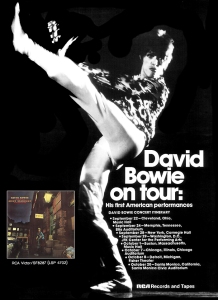
Bowie first started touring Ziggy soon after the recording sessions ended in early 1972, months before the album’s release, with at first small venues and audiences that just slowly grew and grew as the Ziggy hype started to build up momentum. By the time of the album’s release and Bowie appearance on “Top of the Pops”, Bowie’s appeal exploded until even the US market was starting to take notice, with a US tour and shows that likewise started to become sellouts in increasing parts of the country. The Ziggy Stardust shows were more than just mere rock concerts, with more theatre elements introduced that made them must-see spectacular events, both visually and musically, thanks to the super tight band The Spider From Mars had become.
Bowie started Ziggy as a relative unknown. Bowie finished with Ziggy Stardust a short period of 18 months later at the Hammersmith Odeon on 3 July 1973 as a superstar. Bowie was smart enough to know that such successes were but a current trend. Bowie needed to kill Ziggy and move on creatively if he wasn’t to also share in Ziggy’s ultimate fate himself…
There are a number of official live albums that beautifully document the Bowie/Ziggy era. These include:
“Bowie At The Beeb“, a wonderful 2 disc set that included most of the live performances Bowie ever recorded with the BBC during his career. The second disc especially captures live performances of every Ziggy Stardust track except “Soul Love” and “Star”. It really is a superb insight into the live talent that was early, pre-fame David Bowie and is one of my favourite albums. The original release of the album came with a 3rd disc that captured a live BBC studio concert recorded on 27 June 2000 that is also wonderful.

“Santa Monica Live ’72” is one of my all-time favourite live albums and captures Bowie/Ziggy performing live at the Santa Monica arena, LA on Bowie’s first US tour on 20 October 1972. It’s a raw, superb, early insight into a young Bowie that was just beginning to successfully take on the world. Some of the tracks lack the tightness that would come, but it’s all the more poignant for it’s embryonic energy and nervous showmanship. It includes a rare outing of the Velvet Underground’s “Waiting For The Man” and one of THE iconic, beautiful performances of Jacques Brel’s “My Death“. This was many a Bowie fan’s favourite bootleg album before it was semi-officially released 30 June 2008.
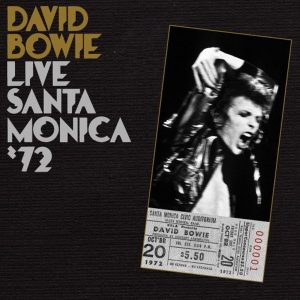
“Ziggy Stardust: The Motion Picture” is the soundtrack album of Ziggy Stardust’s final 3 July 1973 concert at the Hammersmith Odeon, London that was captured for posterity on film by the noted film maker D. A. Pennebaker. While I always found the film to be a little too grainy and unfocused on too may occasions for my liking, it’s still a wonderful if sad document on such an important event in rock history. While Bowie’s final farewell speech always leaves a lump in the throat, there’s no mistaking the amazing performance and sheer energy that Bowie gave on his final official Ziggy outing. The 30th Anniversary 2 CD Special Edition of the album is definitely the version to try and get as it includes much of the show that was cut in earlier versions, although it’s still sadly missing the section where Jeff Beck played on a couple of songs (“Love Me Do/Jean Genie” and “Round And Round”). The highlights are the Velvet Undergound’s “White Light/White Heat” (which was released as a single), “My Death” and the final emotional “Rock ‘n’ Roll Suicide“, although the whole album is brilliant if truth be told.

As Bowie’s most cherished album, its had many re-releases over the years and had the special anniversary treatment more than any other Bowie album. RCA released it on CD format for the first time in 1984 but it first received the special treatment as part of the excellent Ryko/EMI re-issue series in 1990 when it came out in a box format that included a lovely glossy booklet and 5 bonus tracks:
“John, I’m Only Dancing” was the classic follow-up single to “Starman”, released on 1 September 1972. It’s one of Bowie’s finest singles, a glam-rock anthem with The Spiders in inspired form with a driving rock tour de force performance. Ronson’s guitar echoing snarls at the end is perfection. A perhaps ambiguous tale in which the narrator is reassuring John that he is only dancing with the girl “John, I’m only dancing, She turns me on, but I’m only dancing“, where John could be interrupted as being either the girl’s or the narrator’s boyfriend. Considering the recent gay comments, most people interpret as being the latter scenario, which actually makes it quite a hilarious song and shows a rare humorous side to Bowie on record. The single continued Bowie’s momentum and reached No. 12 in the UK charts. There was another version of the single recorded during the later Aladdin Sane sessions (known as the “Sax” version) that was confusingly also released as the single with the same catalogue number. The single was featured the first in a number of excellent videos made with the famous photographer Mick Rock (who was also Bowie’s “official” photographer during the Ziggy period), which featured Bowie and The Spiders From Mars in a studio and in live performance with Lindsay Kemp and his dance troupe during a highly acclaimed concert at The Rainbow Theatre. Watch the video here.
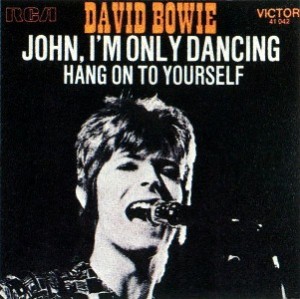
“Velvet Goldmine” recorded during the early Ziggy sessions made its first commercial debut as part of the B-Side to the “Space Oddity” single re-release that finally topped the charts in 1975. It’s a fantastic risqué little gem from this period that fits into the Ziggy narrative from the perspective of a groupie “You got crazy legs, you got amazing head, You got rings on your fingers and your hair’s hot red“. The music is typical Spider’s hard rock, but with a catchy piano based vibe and hooky chorus “I’ll be your king volcano right for you again and again, My velvet goldmine“. The outro with its “Seven Dwarfs” hum-along and whistling makes me smile with each listen. It’s a great song that like so many during this period, deserves more accolades.
“Sweet Head” was the real gem and surprise from this re-issue, as it was a practically unknown track from the Ziggy archives at the time. Believed to considered for the ending of Side One, it was replaced almost certainly due to the sexually charged language that would have made any conservative record executive feel a tad uncomfortable. A bluesy rocker that features Ronson’s fluid guitar playing, it’s perhaps a tad more “conventional” musically than much of Bowie’s output from this period. The lyrics, which features “Ziggy” explicitly (the only other such song being the title track), has content that shall we say is particularly sexually charged, with lines such as “I’m your rubber peacock angelic whore” and “Sweet head, give you sweet head, while ya down there“. There’s no prizes for what this song is ultimately about. I would have loved this track to have replaced “It Ain’t Easy”, but no surprises why is was left out and forgotten until this release.
The other two tracks are demo versions of “Ziggy Stardust” and “Lady Stardust” of interest to hard core fans only who didn’t already have them on bootlegs.
The 30th Anniversary Edition of the album released in 2002 included another lovely little booklet and a bonus disc of additional material that featured the above 3 tracks and the following:
“Moonage Daydream” (Arnold Corns version). One of the many little side projects Bowie had going on during this formative 1971/72 period was a band he put together called Arnold Corns, which was designed (maybe) to highlight the singing talents of one of Bowie’s friends, Freddie Burretti. As it turned out, dear Freddie was much much better at designing clothes than singing and although a number of tracks were recorded, Bowie handled most of the singing (while The Spiders played much of the music). As a practice run for what would become the Ziggy Stardust project, Bowie recorded 2 early versions of tracks that would feature on the Ziggy album. Released as a single on 7 May 1971, one was this version of “Moonage Daydream”, a much slower version with somewhat different lyrics. Featuring a mainly percussion and piano arrangement, it’s an interesting insight on how a song can develop (and drastically improve) over time and with much better production values. The guitar riff here is good, whereas the guitar work on the final album version is extraordinary. The single sadly flopped without a trace, although not all was lost for Burretti who would go on to design much of the Ziggy’s clothing and stage costumes.
“Hang On To Yourself” (Arnold Corns version). The B-side to the above Arnold Corns “Moonage Daydream” single was a very early version of this iconic Ziggy track, again in drastically different form and with different lyrics during the verses. Comparing this to the energised Ziggy classic, this version comes across as a little ploddy and tame. Again, the transformation of a song from average to brilliant is fascinating to witness.
“Round And Round” is a cover of the famous Chuck Berry classic. If you’ve ever wondered what the futuristic Spiders From Mars would sound like playing classic covers at some small English pub, the answer is “fantastic” !! They all sound as if they’re having a blast and it really is a riot. This track was destined to be included on the album until replaced at the last minute with “Starman” to satisfy RCA’s need for a single worthy track be included. As good as this performance is, the Ziggy Stardust album is just unimaginable with Starman. It was first originally released as the B-side to the “Drive-In Saturday” single in 1973.
“Holy Holy” is yet another little gem from the Ziggy era. This is a Spiders From Mars rework of the song originally released as a single that flopped back in 1970. Whereas the original version was a clear nod to Marc Bolan with its almost folky arrangement (and a stark contrast to most of the material from “The Man Who Sold The World” album he had released at the time), this version gest an injection of energy that makes it infinitely superior. Bowie’s vocals are just great here as he wickedly sings “I don’t want to be an angel, just a little bit evil, Feel the devil in me“, but it really is the whole band that shines throughout. Again, originally planned to be included on the Ziggy Stardust album before being shelved, it finally made its first commercial appearance as the B-side to the “Diamond Dogs” single released in 1974. You can still find the original version on the Re:Call 1 disc of the “Five Years” box set and is certainly worth checking out for contrast purposes.
“Amsterdam (Port of Amsterdam)” is a track that has been a little derided by critics over the years. A cover of the 1964 song by Jacques Brel, Bowie gives it here his full histrionics treatment, with a soaring (some say overly pretentious and melodramatic) vocal performance. But I’ve also loved it, especially the way it builds up slowly with the addition of acoustic guitars with each new verse until to reaches its final climax “Throws his nose to the sky, Aims it up above, And he pisses like I cry, On the unfaithful love, In the port of Amsterdam“. Again, at one stage planned to be part of the Ziggy Stardust album, it was dropped and not officially released until it made it on the B-side to the “Sorrow” single. Although I do love this performance, it does pale to the way Bowie usually performs “My Death“, the Jacques Brel song for which Bowie is much more well known to perform live, especially during his Ziggy era.
“The Supermen” is a Ziggy sessions reworking of the track that originally closed his earlier “The Man Who Sold The World” album. As the earlier album had failed to make any impression on the charts and as Bowie initially felt the song could work within the Ziggy framework, it was briefly considered for the Ziggy Stardust album, before being dropped and ultimately forgotten. Unlike most tracks from these sessions, I actually prefer the original version to this one, that ultimately adds little. The song was performed live during many of the earlier Ziggy Stardust shows.
The 40th Anniversary Edition of the album received the full re-mix treatment, which although interesting, is ultimately not a good as the original mix which really is impossible to beat. What though was indeed a super treat was the 5.1 surround sound re-mix that was also included as a DVD with the vinyl edition. This gives the whole album an added dimension and “space” that make for a fabulous listening experience. It’s the same 5.1 mix that was released previously on the SACD format. If you can get your hands on either of these versions and have a surround sound setup, you won’t be disappointed.
I’m already looking forward to what must surely be a very special re-issue come its 50th anniversary in 2022…
“The Rise And Fall Of Ziggy Stardust And The Spiders From Mars” really is an exceptional album, a classic in every definition of the word and an album that truly still sounds fresh and new and “futurist” to this very day. Although one could easily argue that Bowie would go on to record even more cutting edge, musically advanced and technically better albums, I personally regard this as his finest musical achievement.
Just remember whenever you’re lucky enough to play it, it’s: To be played at maximum volume.
Best Tracks: “Five Years“, “Moonage Daydream“, “Rock ‘n’ Roll Suicide“
